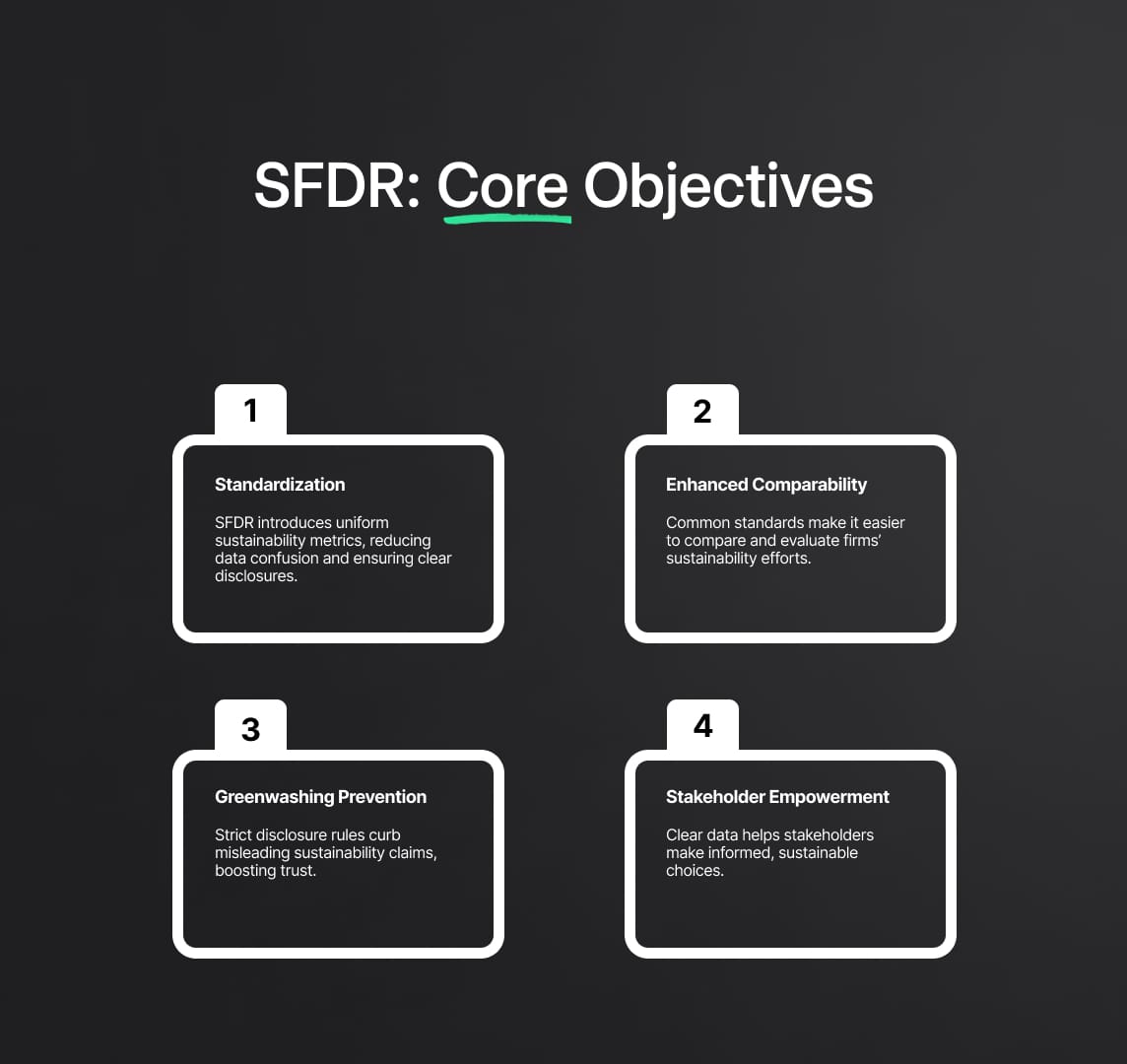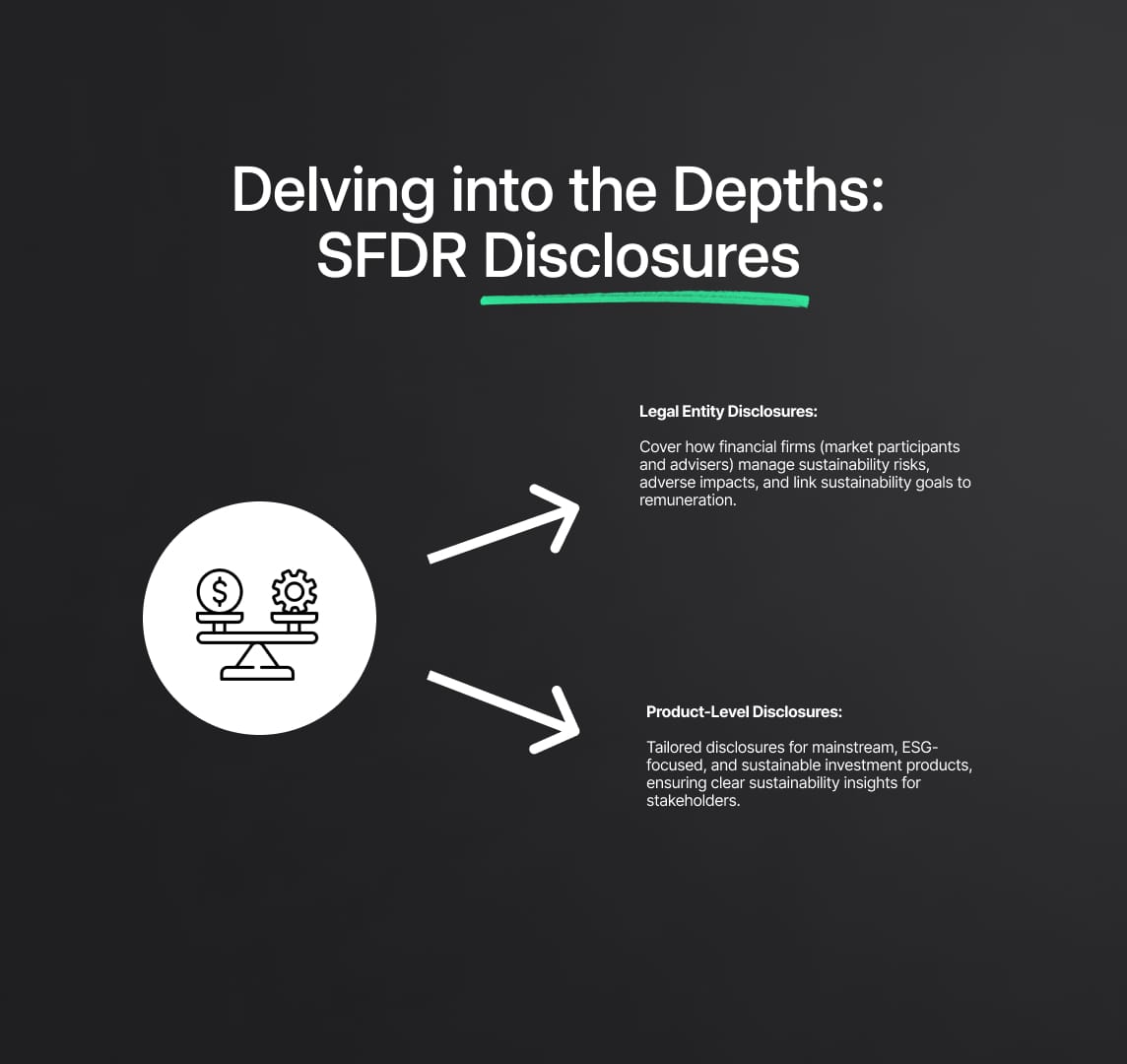Sustainable Financial Disclosure Regulation: SFDR
We discussed the Sustainable Finance Disclosure Regulation (SFDR) and its implications on financial investments. Covering pre-contractual and periodic disclosures, we delved into Articles 9 and 11 of the SFDR, highlighting their importance for transparency and sustainability.

Grand “Answer”:
The Sustainable Finance Disclosure Regulation (SFDR) is a European regulation aimed at enhancing transparency in sustainable investment markets[2]. This regulation applies to financial market participants and financial advisors within the European Union [1][2]. Its primary objective is to prevent 'greenwashing', a practice where companies overstate their environmental credentials to attract investment [1]. It does this by requiring these entities to make disclosures on how they integrate sustainability risks into their investment decisions, and the impact of those decisions on sustainability factors [1][2]. SFDR is a significant step towards achieving the EU's commitment to sustainable growth and climate neutrality by 2050 [1][2].
Source
[1]

Understanding the Sustainable Financial Disclosure Regulation (SFDR): A Comprehensive Overview
In the complex world of the 21st century, sustainability has emerged as a watchword that encapsulates societal and environmental responsibilities. Historically, the financial realm was perceived as being separate from these concerns. However, it's now evident that the financial domain plays a pivotal role in steering global environmental and social trajectories. The European Union, in its visionary stance, introduced the Sustainable Financial Disclosure Regulation (SFDR). It serves as a hallmark of this newfound realization. By ensuring that the financial market becomes a beacon of transparency and accountability, the SFDR attempts to align monetary endeavors with ethical and environmental considerations. Such a transformative step doesn't merely represent a policy change; it underscores the beginning of an era where ethical considerations and financial ambitions coalesce, where transparency isn't just a desired attribute but an integral part of financial operations. The initiation and stringent execution of SFDR underscore the European Union's unwavering commitment to ensuring that environmental, social, and governance (ESG) concerns are not sideline issues but central considerations in financial decision-making.
SFDR: Origin and Purpose
The origins of SFDR can be traced to heightened global cognizance regarding the profound impacts of climate change, loss of biodiversity, and the overarching ethical duties of corporations and financial entities. The term 'greenwashing' emerged as a critique against institutions that feigned environmental responsibility without implementing real changes. These pseudo-environmental claims did more than mislead the public; they threatened the legitimacy of genuine sustainable endeavors. To mitigate the spread of such practices and to instill genuine transparency, the European Union championed the cause of SFDR. This regulatory framework's primary purpose encapsulates two core objectives: first, to mandate financial market participants and advisers to disclose how ESG risks permeate their investment decisions. Second, to ensure that commitments to sustainability are verifiable, tangible, and devoid of empty rhetoric. By pushing for genuine disclosure, the EU seeks to foster an environment where stakeholders can make informed decisions based on accurate, comprehensive information about financial entities' sustainability practices.

Key Objectives of the SFDR: Beyond Just Disclosure
While disclosure remains a foundational pillar of the SFDR, it's vital to understand that this regulation envisages a broader, more transformative change within the financial industry.
- Standardization: Amidst the multifaceted global financial tapestry, the absence of uniform sustainability metrics or guidelines can lead to a convoluted array of data, rendering it ambiguous and open to misinterpretation. The SFDR pioneers a path to standardization, ensuring disclosures are not only thorough but decipherable and consistent across entities.
- Enhanced Comparability: By setting a universally acceptable disclosure standard, the SFDR ensures that organizations can be evaluated using a consistent metric. Such comparability empowers stakeholders, allowing them to discern and differentiate between entities based on their sustainability credentials, fostering a genuinely transparent market scenario.
- Greenwashing Prevention: Greenwashing isn't merely an ethical concern; it erodes trust within the financial sector. By setting stringent disclosure guidelines, the SFDR seeks to mitigate misleading sustainability claims, holding entities accountable to their public commitments.
- Stakeholder Empowerment: By ensuring transparency, the SFDR empowers stakeholders—allowing them to make informed decisions based on accurate sustainability data, fostering trust, and promoting genuine sustainable practices in the industry.
Role of European Supervisory Authorities: The Framework's Stewards
For any regulatory framework to be effective, it necessitates robust implementation mechanisms. In the case of SFDR, the European Supervisory Authorities have emerged as its vigilant guardians. These bodies, beyond their role in shaping the regulation, have been instrumental in its nuanced implementation. Their approach isn't merely bureaucratic; it's deeply research-driven. Recognizing the dynamic nature of the financial realm, these authorities have been actively engaged in extensive research, stakeholder consultations, and in-depth analysis of global sustainability trends. Their commitment ensures that the SFDR remains adaptable and relevant, capable of addressing both contemporary challenges and future complexities. Their role underscores the importance of collaboration between regulatory bodies and financial entities, creating a symbiotic relationship where regulations and market realities inform and refine each other.

Delving into the Depths: SFDR Disclosures
SFDR's disclosure guidelines, in their intricacy, offer a holistic view of how sustainability permeates financial operations.
- Legal Entity Level Disclosures: This level of disclosure delves deep into the core of financial entities. Two primary entities fall under this ambit: 'Financial Market Participants', who offer SFDR-compliant products, and 'Financial Advisers', professionals providing insights on these products. These disclosures delve into their decision-making processes, examining the integration of sustainability risks, potential negative impacts, and the alignment of remuneration policies with sustainability objectives.
- Product-Level Disclosures: The SFDR recognizes the diverse range of financial products available in the market. To ensure comprehensive disclosure, products are segmented into 'Mainstream Products', 'Environmental or Social Characteristic Products', and 'Sustainable Investment Objective Products'. Each segment, given its unique sustainability attributes, has tailored disclosure requirements ensuring that stakeholders get a comprehensive view of the product's sustainability credentials.
Sustainable Investment can be likened to the heart of modern financial strategies. It extends beyond mere monetary profits, targeting positive environmental and social impacts. Article 10 of SFDR delves into this principle, outlining the exact content that should be made accessible to both investors and the broader audience. Specifically, the SFDR, or Sustainable Financial Disclosure Regulation, aims to promote transparency in the finance industry, emphasizing the significance of a greener and more socially-responsible approach to investment. This new framework obligates firms to be more transparent about their sustainable investment processes and their impact. With rising global concerns about climate change and societal challenges, this regulation comes at a crucial time, aiming to shift the financial market towards more responsible practices.
Decoding Website Disclosures Under SFDR
Websites play a pivotal role in today's digital age. Recognising this, the SFDR mandates that any fund or portfolio targeting sustainable investments should display specific data conspicuously on their online platforms. The Investment Objective should be succinctly described, illuminating the goal of sustainable investment. Furthermore, methodologies, which are central to understanding the impact of sustainable investments, need full disclosure. This extends from the data sources leveraged, the criteria set for underlying assets, to the sustainability indicators. These indicators function as yardsticks, reflecting the overall positive footprint of the fund. In an era where investors are becoming increasingly eco-conscious, such insights can significantly influence investment decisions. Transparent disclosures also foster trust, bolstering investor confidence in the fund's sustainable initiatives.
Uniformity is crucial when interpreting data across the finance landscape. Recognizing this, the European Supervisory Authorities (ESAs) are tasked with designing regulatory technical standards. These standards will spell out the nitty-gritty regarding content, presentation, and other details of disclosure requirements set by SFDR. Given the evolving nature of financial products and a constant technological progression, the ESAs are primed to update these standards periodically. This proactive approach ensures that disclosures remain relevant, aiding investors in making informed decisions grounded in the latest regulations and technological advancements.
Navigating Pre-contractual Disclosures (Article 9, SFDR)
In the labyrinth of financial investments, pre-contractual disclosures stand as guideposts for potential investors. Article 9 of the SFDR is not just a regulatory standard but a beacon for transparency and accountability. Investors are entitled to know the nitty-gritty of what they're delving into. This means when a financial product claims to be sustainable and references a particular index, it should not only illuminate its alignment with the said index but also detail how it differs from a more generalized market index.
Why does this matter? As the world leans more towards sustainability, investors are discerning. They seek to align their investments with their personal and global visions for a sustainable future. Here's where the Paris Agreement becomes significant. Financial products, especially those targeting carbon emission reductions, should resonate with these larger global objectives. This alignment is not just an obligation but a testament to an institution's commitment to global sustainability.
Periodic Disclosures in Light of Article 11, SFDR
Trust, in the financial realm, isn't built in a day. It's a continuous process, nurtured by consistent communication and updates. This is where the essence of Article 11 of the SFDR emerges. Starting from 1 January 2022, institutions like AIFM, UCITS management companies, and MiFID investment firms are required to punctually serve disclosures. This periodicity ensures that the investor community is never in the dark.
The content isn't just a mirror reflection of website data but an evolving narrative of the product's journey towards sustainable goals. These updates, ranging from performance metrics to new sustainable initiatives, empower investors. They are equipped with real-time insights to gauge the alignment of their investments with their sustainable vision.
Taxonomy Regulation and SFDR
To truly grasp the expansive vision of sustainable investments, one must understand the intertwining of Taxonomy Regulation with the SFDR. Portfolios that champion "environmentally sustainable investments" are placed under a sharper microscope. The regulations demand a dual-fold compliance: adherence to the SFDR's mandate and a comprehensive account of their environmental aspirations.
This might seem like a tall order, but it's essential. When funds elucidate their alignment with "environmentally sustainable" economic activities, it paves the way for investors to navigate with clarity. This isn't just about regulatory checkboxes but a profound shift towards an eco-conscious investment landscape. Every disclosure, every report is a step towards aligning global capital with a vision for an environmentally resilient future.
Synergy with EU Taxonomy Regulation
The SFDR, in its standalone might, is formidable. However, its true strength is manifested when it operates in tandem with the EU Taxonomy Regulation. This sister regulation offers a classification system for sustainable activities, serving as a lexicon of what constitutes 'sustainable'. When financial entities disclose their sustainability practices under the SFDR, they're now bound by a clear, universally accepted definition. This synergy eradicates ambiguity, strengthens the robustness of disclosures, and ensures that the term 'sustainable' isn't diluted or misused, preserving its sanctity and integrity.
Grand Answer: Your AI Partner
Designed to support compliance officers, legal counsels, and other professionals responsible for adhering to regulatory standards, Grand Answer aims to facilitate an efficient and straightforward compliance process.
Reduce your
compliance risks


